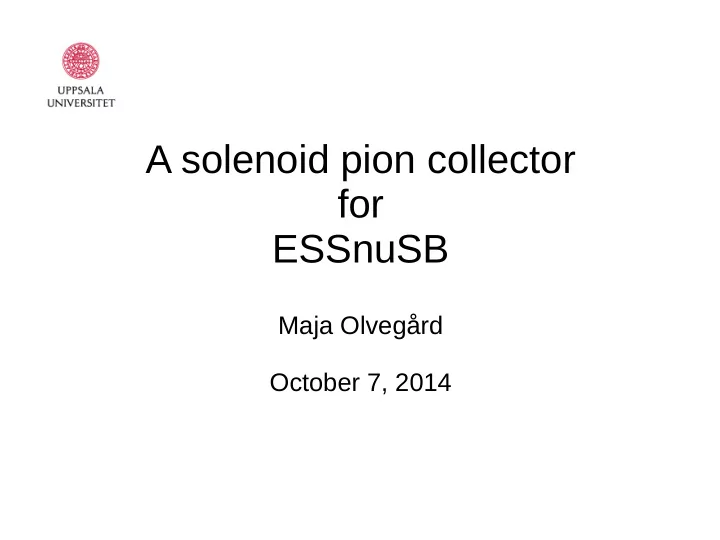

A solenoid pion collector for ESSnuSB Maja Olvegård October 7, 2014
Magnetic Pion Collectors ● Positron sources – matching to accelerator optics ● Neutrino factories / Muon colliders – nature of focusing? matching? ● Superbeam facilities – point-to-parallel focusing
Three solenoid types Quarter Wave Transformer Adiabatic device Standard (QWT) (AD) (S) beam
The pions Pion distribution provided by N. Vassilopoulos. ● Large momentum spread ● Large angular divergence – Max intensity at ● What energy (range) are we targeting? – Single energy (standard solenoid) – Maximum energy? (adiabatic solenoid) – Central energy? (quarter wave transformer) Specifications from Physics needed!
Important problems ● Hard-edge done. Turn to “physical” magnet with fringe fields. ● Source inside or (partially) outside the solenoid? ● How to do the charge separation? coil ― Add a chicane? ― Tilt the solenoid? ● Available space? ● How much contamination can we accept? ● Later: try more complex systems (e.g. adiabatic solenoid system)
Tracking codes ● Several codes for particle tracking: source magnet availability comment import Parmela/Parmila 3D yes map UU license exists. Tredi 3D GPT 3D ? map License required. Astra Open source IMPACT PARTRAN Matlab “manual” work ● Particle interaction with matter: FLUKA/GEANT4
Strategy ● Potential showstoppers: a) The solenoid provides significantly (at an unacceptable level) lower collection efficiency b) The charge separation is too complex. c) The heat load on the superconducting coil is excessive. ● Strategy to deal with the scenarios above: If a) and/or b) is true, terminate the study. – If a) and b) are false, increase efforts to face c). – ● Timeline: Investigate a) and b) before March 2015. – Boundary conditions: – ● Design study application is approved. ● My contract expires June 30, 2015.
Available resources ● Jean-Pierre ● Maja – part time until July 1, 2015 ● Volker ● Roger ● ...
Hard-edge solenoid ● Source outside of solenoid – a max to be captured ● Source inside the solenoid – discrete energy selection: Particles with momenta will exit the magnet with zero transverse momentum ( = point-to-parallel focusing)
Available space ● Pion rest mass and half life ● Pion momentum and total energy ● Relativistic gamma factor ● Pion speed ● Distance traveled in lab frame ( for ) ( for ) ● Muon life time ~100 time longer. Rest mass about the same which means that muons travel ~100 times longer before decaying.
Recommend
More recommend